However, it is central to monastic ordination ceremonies and initiates are require to have a master. This is purely for guidance. The three jewels of Buddhism is not typically something you can teach yourself.
But becoming a Buddhist monk is not easy; there are strict rules to follow. Most monasteries rise at 3.30 or 4am to pray to Buddha. Monks eat two meals a day, and not after 12pm. They promise not to harm any living creatures (including pesky mosquitos) and must abstain from sex, alcohol and mind-enhancing drugs.
Of course, you do not have to become a monk to practise Buddhism, but taking refuge in the three jewels requires a certain amount of dedication, patience and learning.
Buddhism values life choices and encourages practitioners to cultivate wisdom and compassion. It teaches that by taking responsibility for your actions, you receive better rewards in accordance with natural law. This is the theory of karma.
The triple gems of Buddhism do not solely focus on the application and knowledge of the practitioner, but also the willingness to teach others. The three qualifying qualities are:
Buddha means “the enlightened one.” We are all born Buddha’s but as children do not realise this. As we grow older and become conditioned by a toxic education system, media, phoney leaders and materialism, we forget we are blessed with innate powers of higher consciousness. Instead, we become cattle.
Unless you have illuminated parents or a real spiritual teacher and not some indoctrinated church vicar, it takes a lot of hard work to reprogram your adult mind and rediscover the pure consciousness you were born with.
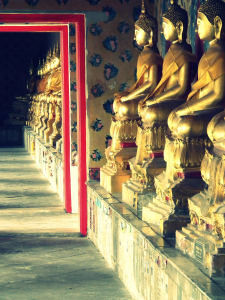
The majority of people develop faulty hard-wiring and rather than becoming enlightened, stay ignorant and wallow in base-consciousness like a beast. This generally leads to mental breakdowns and terminal illness.
However, the world is slowly waking from its slumber and life philosophies are beginning to creep back into public consciousness. The knowledge of consciousness which leads to Buddha state is creeping to the surface.
The corrupt teaching of higher consciousness that goes under the name of “religion” and “spirituality,” will eventually wither and die.
Many people are starting to wake up to the fact that expanding conscious awareness relies on integrating unconscious archetypes into the conscious mind. You just need to know where to look.
But to coin a phrase, “the truth is out there.” Actually, it’s in you, but you often need guidance from external sources to help find it.
The truth is that you are pure consciousness and when you learn to take control of your own mind you will find your way back to source. This is what it takes to be a Buddha. It is symbolised by fork lightning.
Like every concept in Buddhism, Dharma comes straight from the Hindu philosophy and essentially describes the factors of existence. In other words, the law of Karma that dictates every action you make now has a reaction later. This is cosmic law and there is no escape.
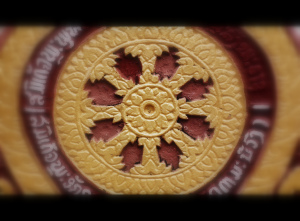
Dharma refers to ethical rules and the ability to control the mind; thoughts, motives, actions. Essentially it is your duty in life, and in Buddhism, it is symbolised by the Dharma Wheel and taught in the Noble Eightfold Path.
In brief, the laws of nature determine your circumstances based on whether you have carried out your Dharma in accordance with rules of what is right and wrong. Acting in good faith and with the best intentions brings prosperity. Otherwise, you suffer the consequences. Or so the theory goes.
You could say that Dharma is Karma, but really Karma is the result of Dharma. All these regurgitated philosophies and theories are merely labels. Ignore them.
Gautama Buddha said, “my teachings are not a philosophy…but to help others have a direct experience of reality.” (Old Path White Clouds by Thich Nhat Hanh). It is the path of truth that takes you home to absolute consciousness.
To be Sangha is to be a Buddhist practitioner that teaches others the art of living to others using the teachings of Gautama Buddha. They are tasked with helping their student attain enlightenment.
Singing the Sangha often means the master follows the path of a monastic life, although there are many Buddhist teachers in various parts of the world that live perfectly a normal life.
The word ‘Sangha” is an ancient Sanskrit word meaning assembly or company. Essentially, it is a community of spiritually enlightened Buddha’s committed to pulling people from samsara (illusion/hell) into satori/nirvana (the truth/heaven). You will probably find Sangha’s in your local Buddhist Centre.
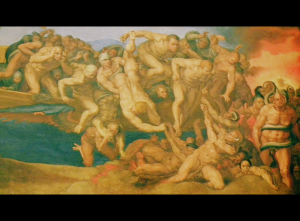
Sangha is symbolised by the conch shell which means to speak the truth. When you speak the truth with the right intention, life becomes much easier. People respect you and you generally get what you need without even trying.
The three jewels of Buddhism sounds much more difficult than it actually is if you dedicate time to practice and get over the initial hurdles. It is not necessary to denounce an ordinary lifestyle in the way monks do. That is a personal choice.
If you choose to be precious, you will still shine leading a normal, everyday life. So be a jewel. Actually, be three.
The story of Matsya and Manu is a Hindu creation story which shares many similarities with the biblical story of Noah. But fish symbolism is found in many cultures throughout the world to represent creation.
The mainstream interpretation is of fish symbolism is they represent happiness and good fortune. As the fish avatar Matsya, Vishnu rescues mankind thus rewarding mankind with life and prosperity.
Buddhists like to think by practising dharma they will have good luck as they do not fear “drowning” in the ocean of suffering and can choose their rebirth like fish in water.
The two fish are associated with the sacred rivers of the Ganges and Yamuna in India – life-giving water that helped civilisation thrive along their fertile banks.
In turn, the rivers symbolically represent the lunar and solar channels of the nostrils which determine the alternating rhythms of breath; inhalation and exhalation.
Furthermore, it was known to Vedic medicine men that one nostril is always partially blocked so that we take more air in through one nostril at any one time.
It is said the two fish depicted in Buddhist iconography is because fish often swim in pairs. I am not convinced this is true based on my casual observations of fish over the years…
…nor am I convinced about the orthodox interpretations of fish handed down by the echelons of Buddhist philosophy. Let’s take a closer look!
It is true that fish represent the bringing of life and prosperity in symbolism, but not quite in the way organised religions want you to believe.
They are of course associated with water, from which all life is said to have developed and rivers are critical to flourishing civilisations even today.
In connection with water, fish also represents creation. Water is an element that creates life. A human foetus lives in water in the mother’s stomach.
The birth of a healthy child does bring happiness and when the child survived in ancient times, it was considered good luck and brought prosperity to the family. Children worked for the family and continued the bloodline.
Two fish are not only found in Buddhist symbolism, but also in other cultures such as this ceramic bowl at Nazca in Peru.
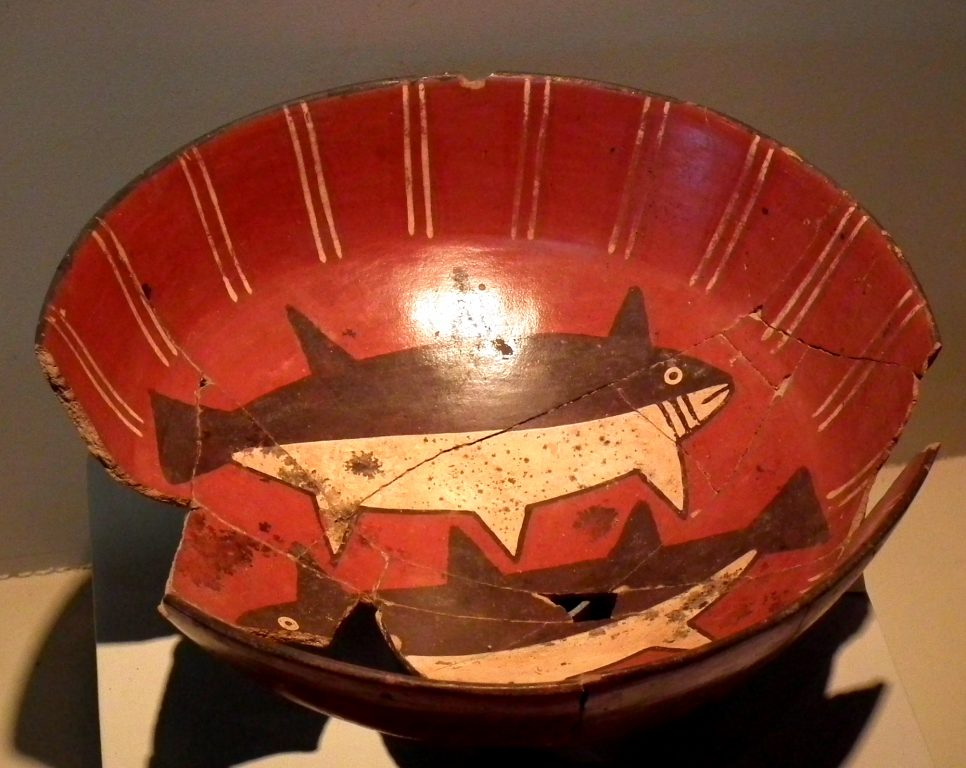
We find the same principles in modern traditions of marriage when male and female join together in (sexual) union. Positive and negative charges of energy also bond to form matter and creation. Whereas water represents consciousness, fish represents the elements that create the world. Our world. Your world.
Plaques and ornaments with symbols of two fish are typically offered to newly married couples in China as a symbol of conjugal rights and fidelity.
The correct interpretation of this marriage symbol is not entirely about sexual intercourse between man and wife, but the “chemical wedding” of male and female energies and the union of mind and heart.
When the thought and emotion are brought into balance, we experience higher consciousness which enables us to act with more clarity and rationality.
When the right/left hemispheres of the brain are unbalanced we are prone to suffer from mood swings and confusion. Feelings of anger, hatred, jealousy and other fear-based emotions lead us into making wrong choices.

The two golden fish, therefore, represents the ability to create through the balance of body and mind which are the vehicles that help us reach higher-consciousness – what Buddhists call Nirvana or Samadhi.
In Vedic chronology, Matsya also represents the first stage in the evolution of life. From an esoteric point of view, this is the birth of a new idea that can be developed to create something you want in your life.
So two fish symbolise the ability to create good fortune and prosperity in your life – and this ability is innate within you. How much you achieve depends on how balanced you are in body and mind.
It is easy for us to allow our emotions to run away with us, and the Buddha, together with other religious texts and philosophies, explain how mastery of the self is the principle ingredient of happiness.
Whilst ever we live in a state of ignorance, we experience negative emotions which ultimately cause disharmony and distraction. The victory banner symbolises triumph over negative emotions.
Today, the banner is typically found as a flag on the roof of temples as a sign of victory. In the Mahabharata, Krishna’s chariot is also adorned with a banner bearing the image of the monkey-god, Hanuman.
Hanuman represents our mischievous nature that ultimately gives in to our dark, sinful thoughts. You know those moments of temptation where you id wants something, but your ego knows you shouldn’t…
…that’s the God Hanuman.
Overcoming this aspect of desire is a personal victory over your emotions. The Victory Banner in Buddhism celebrates the achievement of mastering all negative emotions.
The symbol was adopted by early Buddhists to celebrate the enlightenment of the Buddha – heralding the triumph of self-mastery over ignorance.
The Buddha said there are four aspects of human nature that hinders the course of an individual’s path towards enlightenment. He called them “Mara.”
Once you have conquered these four negative traits, the Buddha says you can reach nirvana.
It is the challenge for individuals seeking enlightenment therefore to master your emotions, after which you will naturally find happiness from within and your external surroundings.
The victory banner in Buddhism is also associated with the element of air. Flags do not come to life without wind.
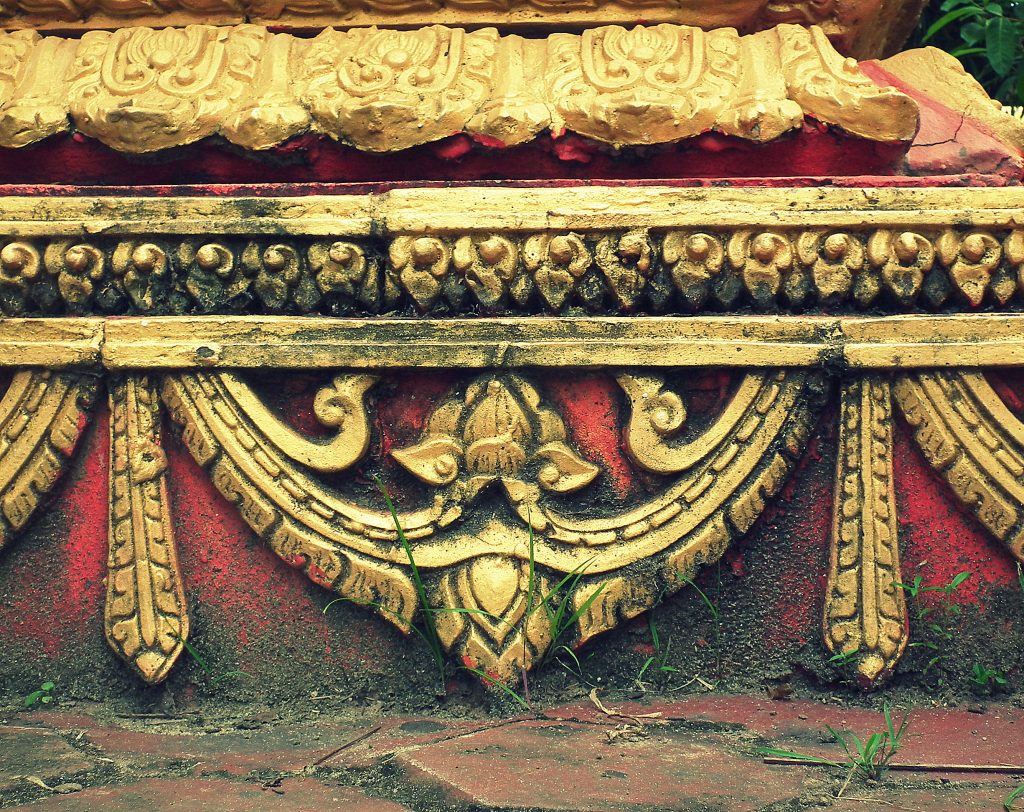
Air, of course, is one of the four principal elements used in alchemical symbolism, astrology and other divination practices. It is associated with thought and emotion. In the chakra system, it is connected to the heart chakra.
The victory banner also relates to knowledge and wisdom and encompasses compassion and ethics which are traits that come from the heart.
Essentially, it is through your feelings towards things, and others, together with the ability to analyse knowledge through thought that allows you to take charge of your environment.
A good place to start doing this is with Buddha’s Four Noble Truths.
Today the vase is typically used to collect money, thus alludes to material wealth. However, its true esoteric and spiritual meaning relates to the liberation of the mind.
The treasure trove is a somewhat ironic symbol. On the one hand, mainstream Buddhism talks about the rich benefits of learning how to become a Buddha. Is there any greater scope of wealth than enlightenment?
Gautama Buddha said that all suffering comes from attachment to desire and that to end suffering one has to cease caring about end results. J Krishnamurti echoed these sentiments when he said the secret to life can be summed up in five words:
“I don’t mind what happens!”
The organised religion of Buddhism today declares the “vase of inexhaustible treasure” represents the wealth of knowledge and spiritual abundance given to us by the Buddha.
Yet observe a Buddhist society and you find worshippers offering food, money and gifts to monks. Others stuff valuable goods placed in treasure vases placed on altars in churches and mountain shrines.
Buddhist monks accept these offerings with grace, but how much valuable and “wealth” giving knowledge do they part with in return?
In my own experience, they don’t share a great deal. Other than providing basic meditation techniques and the odd philosophy, it is not what I would describe as rich content.
It’s a start, but it is not the profound wisdom you can learn by studying the self. But how do you find your Buddha within? It’s not easy!
It is my view that the organised religion of Buddhism does not share this wisdom of self-realisation with laypeople. You have to find the truth for yourself.
And when you know the true symbolic meaning of the treasure vase, you have valuable knowledge from which you can draw inspiration and connect with your inner-Buddha.
If you take the half-truths given in mainstream Buddhism, we understand the treasure vase symbolises wealth, liberation and spiritual abundance.
More significantly, we can interpret that to actually mean the acquisition of wealth and liberation through spiritual practice. And you do that by understanding your true nature.
As you can see in the diagram below, each of the chakras is represented within the design of the treasure trove.
The seventh energy centre, the crown chakra is represented by the white flames inside the oval top that also represents the third eye chakra, the mind’s eye, or All-Seeing Eye.
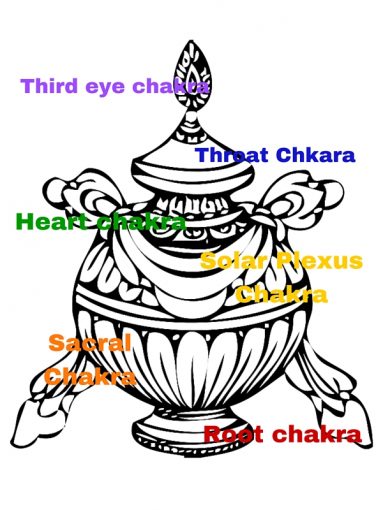
Portrayed in Buddhist iconography as a rotund base and short slim neck, the treasure vase shares similarities with the Florence flask used in alchemical symbolism of medieval Europe.
Alchemical artists used a chemistry flask to represent the tanden and the central nervous system. In essence, the design is a representation of the seven tier chakra system which ancient sages say is central to spiritual growth.
The ancient Ayurvedic sages taught the energy centres of the chakra system have special powers that can be used for attaining and retaining perfect health.
The seven chakras can also be used to advance spiritual growth by means of self-realisation, and the ancient alchemists of Europe described this using the Florence flask that is used for the dissolution process in chemistry.
Throughout the medieval period, scientists pursued the hobby of turning base metals into gold, following the principles written by wise men. It is still believed today that the practice of alchemy is about transforming metal.
The alchemical process involves dissolving basic instincts, desires, defilements, ignorance, and fear and replacing it with love and positive energies.
We find the same connotation of material wealth applied to the treasure vase in Buddhism, although the real wealth comes by way of opening the chakras and using the energy to heal and find peace within oneself.
The riches you procure from the Buddhist treasure vase, therefore, is self-actualisation, the unburdening of the mind and liberation from material bondage.
Although modern-day Buddhists use the treasure vase as a vessel to give money in return for good karma, it has nothing to do with the gain of material wealth.
However, you can acquire spiritual wealth once you understand what the treasure vase actually symbolises. Your energy centres. And Buddhists do not tell you this.